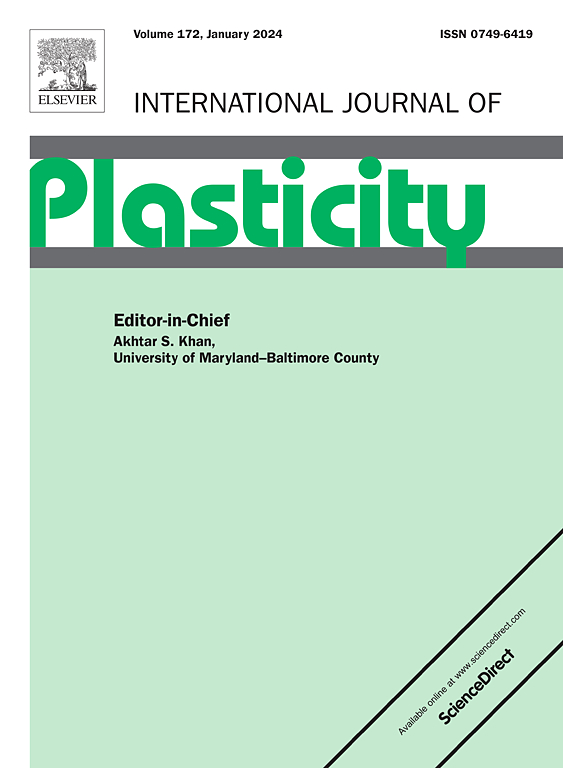Multiscale analysis and modeling of nano-coating fracture induced by inhomogeneous plastic deformation of polycrystalline metallic substrate
IF 12.8
1区 材料科学
Q1 ENGINEERING, MECHANICAL
引用次数: 0
Abstract
Nanocrystalline coatings are critical for extensive applications, yet their fracture on polycrystalline metallic substrates severely deteriorates the performance. Nevertheless, the underlying coating fracture mechanism correlated with inhomogeneous substrate plasticity remains ambiguous, and accurately predicting the crack formation is challenging. To address these issues, this study comprehensively characterized 100-nm niobium coating cracks on stainless-steel sheets and developed a multiscale model to predict coating fracture dominated by substrate plasticity. In particular, different coating cracks were identified and classified into three patterns based on their locations: on intragranular slip bands, grain boundaries, and twin boundaries of the substrate. Crystallographic calculations and statistical analyses demonstrated that the coating fractures were induced by grain and sub-grain scale strain localization of the substrate, which was incorporated within a multiscale modeling framework. For nanocrystalline coatings, molecular dynamics simulations were employed to derive the cohesive zone model in the extended finite element method. The coating fracture was subsequently simulated on a representative volume element of the substrate containing discrete slip bands, which was developed based on crystal plasticity and calibrated using slip steps. Microscopic substrate slips with Burgers vectors oriented at 30° to 50° relative to the surface were revealed to trigger coating cracks, which were generalized with a fracture parameter to be efficiently implemented in macroscopic simulations. Compared to traditional homogeneous models, the developed model enabled precise identification of all coating crack patterns in practical samples. This multiscale modeling procedure and these in-depth insights facilitate the prevention of failure in engineered components with nano-coatings.


多晶金属基体非均匀塑性变形致纳米涂层断裂的多尺度分析与建模
纳米晶涂层是广泛应用的关键,但其在多晶金属基体上的断裂严重影响了涂层的性能。然而,与基体塑性不均匀相关的涂层断裂机制仍然不明确,准确预测裂纹形成具有挑战性。为了解决这些问题,本研究全面表征了不锈钢板上100 nm铌涂层裂纹,并建立了一个多尺度模型来预测基体塑性主导的涂层断裂。根据裂纹的位置,将不同的涂层裂纹划分为三种类型:晶内滑移带、晶界和基体孪晶界。晶体学计算和统计分析表明,涂层断裂是由基体晶粒和亚晶粒尺度应变局部化引起的,并将其纳入多尺度建模框架。对于纳米晶涂层,采用分子动力学模拟方法推导了扩展有限元方法中的内聚区模型。随后,在包含离散滑移带的基材的代表性体积单元上模拟涂层断裂,该单元基于晶体塑性开发并使用滑移步骤进行校准。揭示了以相对于表面30°~ 50°为取向的Burgers矢量引发涂层裂纹的微观基体滑移,并将其推广为一个断裂参数,以便在宏观模拟中有效地实现。与传统的均匀模型相比,所建立的模型能够准确识别实际样品中的所有涂层裂纹模式。这种多尺度建模程序和这些深入的见解有助于预防纳米涂层工程部件的失效。
本文章由计算机程序翻译,如有差异,请以英文原文为准。
求助全文
约1分钟内获得全文
求助全文
来源期刊

International Journal of Plasticity
工程技术-材料科学:综合
CiteScore
15.30
自引率
26.50%
发文量
256
审稿时长
46 days
期刊介绍:
International Journal of Plasticity aims to present original research encompassing all facets of plastic deformation, damage, and fracture behavior in both isotropic and anisotropic solids. This includes exploring the thermodynamics of plasticity and fracture, continuum theory, and macroscopic as well as microscopic phenomena.
Topics of interest span the plastic behavior of single crystals and polycrystalline metals, ceramics, rocks, soils, composites, nanocrystalline and microelectronics materials, shape memory alloys, ferroelectric ceramics, thin films, and polymers. Additionally, the journal covers plasticity aspects of failure and fracture mechanics. Contributions involving significant experimental, numerical, or theoretical advancements that enhance the understanding of the plastic behavior of solids are particularly valued. Papers addressing the modeling of finite nonlinear elastic deformation, bearing similarities to the modeling of plastic deformation, are also welcomed.
 求助内容:
求助内容: 应助结果提醒方式:
应助结果提醒方式:


